radio PONTIAC VIBE 2008 Owner's Guide
[x] Cancel search | Manufacturer: PONTIAC, Model Year: 2008, Model line: VIBE, Model: PONTIAC VIBE 2008Pages: 368, PDF Size: 5.7 MB
Page 271 of 368
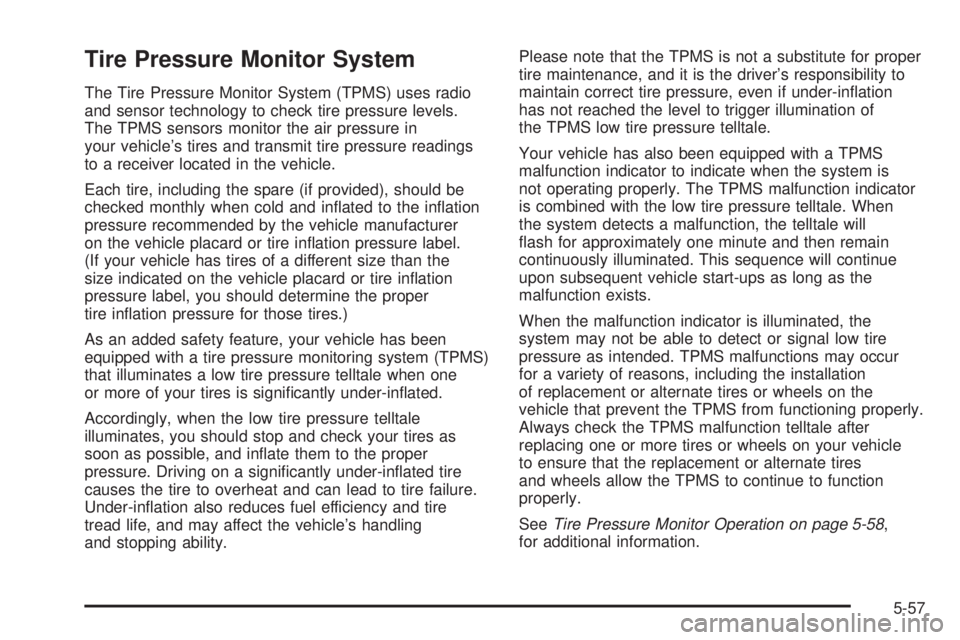
Tire Pressure Monitor System
The Tire Pressure Monitor System (TPMS) uses radio
and sensor technology to check tire pressure levels.
The TPMS sensors monitor the air pressure in
your vehicle’s tires and transmit tire pressure readings
to a receiver located in the vehicle.
Each tire, including the spare (if provided), should be
checked monthly when cold and in�ated to the in�ation
pressure recommended by the vehicle manufacturer
on the vehicle placard or tire in�ation pressure label.
(If your vehicle has tires of a different size than the
size indicated on the vehicle placard or tire in�ation
pressure label, you should determine the proper
tire in�ation pressure for those tires.)
As an added safety feature, your vehicle has been
equipped with a tire pressure monitoring system (TPMS)
that illuminates a low tire pressure telltale when one
or more of your tires is signi�cantly under-in�ated.
Accordingly, when the low tire pressure telltale
illuminates, you should stop and check your tires as
soon as possible, and in�ate them to the proper
pressure. Driving on a signi�cantly under-in�ated tire
causes the tire to overheat and can lead to tire failure.
Under-in�ation also reduces fuel efficiency and tire
tread life, and may affect the vehicle’s handling
and stopping ability.Please note that the TPMS is not a substitute for proper
tire maintenance, and it is the driver’s responsibility to
maintain correct tire pressure, even if under-in�ation
has not reached the level to trigger illumination of
the TPMS low tire pressure telltale.
Your vehicle has also been equipped with a TPMS
malfunction indicator to indicate when the system is
not operating properly. The TPMS malfunction indicator
is combined with the low tire pressure telltale. When
the system detects a malfunction, the telltale will
�ash for approximately one minute and then remain
continuously illuminated. This sequence will continue
upon subsequent vehicle start-ups as long as the
malfunction exists.
When the malfunction indicator is illuminated, the
system may not be able to detect or signal low tire
pressure as intended. TPMS malfunctions may occur
for a variety of reasons, including the installation
of replacement or alternate tires or wheels on the
vehicle that prevent the TPMS from functioning properly.
Always check the TPMS malfunction telltale after
replacing one or more tires or wheels on your vehicle
to ensure that the replacement or alternate tires
and wheels allow the TPMS to continue to function
properly.
SeeTire Pressure Monitor Operation on page 5-58,
for additional information.
5-57
Page 272 of 368
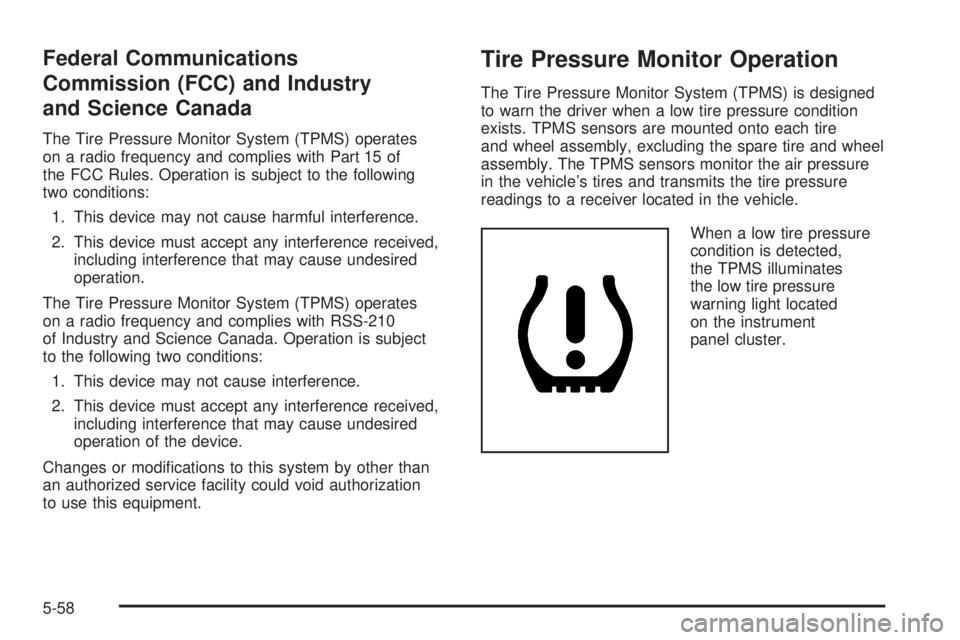
Federal Communications
Commission (FCC) and Industry
and Science Canada
The Tire Pressure Monitor System (TPMS) operates
on a radio frequency and complies with Part 15 of
the FCC Rules. Operation is subject to the following
two conditions:
1. This device may not cause harmful interference.
2. This device must accept any interference received,
including interference that may cause undesired
operation.
The Tire Pressure Monitor System (TPMS) operates
on a radio frequency and complies with RSS-210
of Industry and Science Canada. Operation is subject
to the following two conditions:
1. This device may not cause interference.
2. This device must accept any interference received,
including interference that may cause undesired
operation of the device.
Changes or modi�cations to this system by other than
an authorized service facility could void authorization
to use this equipment.
Tire Pressure Monitor Operation
The Tire Pressure Monitor System (TPMS) is designed
to warn the driver when a low tire pressure condition
exists. TPMS sensors are mounted onto each tire
and wheel assembly, excluding the spare tire and wheel
assembly. The TPMS sensors monitor the air pressure
in the vehicle’s tires and transmits the tire pressure
readings to a receiver located in the vehicle.
When a low tire pressure
condition is detected,
the TPMS illuminates
the low tire pressure
warning light located
on the instrument
panel cluster.
5-58
Page 274 of 368

Replacement tires or wheels do not match your
vehicle’s original equipment tires or wheels. Tires
and wheels other than those recommended for your
vehicle could prevent the TPMS from functioning
properly. SeeBuying New Tires on page 5-63.
Operating electronic devices or being near facilities
using radio wave frequencies similar to the TPMS
could cause the TPMS sensors to malfunction.
If tire chains are installed on the vehicle.
If there is a lot of snow or ice around the wheels
or wheel housings.
If a window tint that affects the radio wave signals
is installed.
If the TPMS is not functioning it cannot detect or
signal a low tire condition. See your dealer/retailer
for service if the TPMS malfunction light comes on
and stays on.
TPMS Reset
In order for the tire pressure monitoring system to work
properly you need to reset (initialize) the tire pressure
monitoring system. Any time you repair or replace a tire
or wheel, or rotate the tires the tire pressure monitor
system needs to be reset.
Do not reset (initialize) the system without �rst correcting
the cause of the low-tire condition. If the system is reset
when the tire pressures are incorrect, the system will
not function properly and might not alert you when a
tire is low.
When initializing the system, the present tire in�ation
pressure is stored as standard. The tire pressure warning
system determines decreased air pressure by comparing
the present and the standard tire in�ation pressures.
When you change the set tire in�ation pressure, it is
necessary to initialize the tire pressure warning system.
To reset (initialize) the system:
1. Park the vehicle at a safe place and apply the
parking brake. Turn the engine off.
2. Turn the ignition to ACC/ACCESSORY or
LOCK/OFF.
3. Adjust the tire pressure of all the installed tires
to the speci�ed cold tire in�ation pressure level.
4. Turn the ignition to ON/RUN with the engine off.
5-60
Page 305 of 368
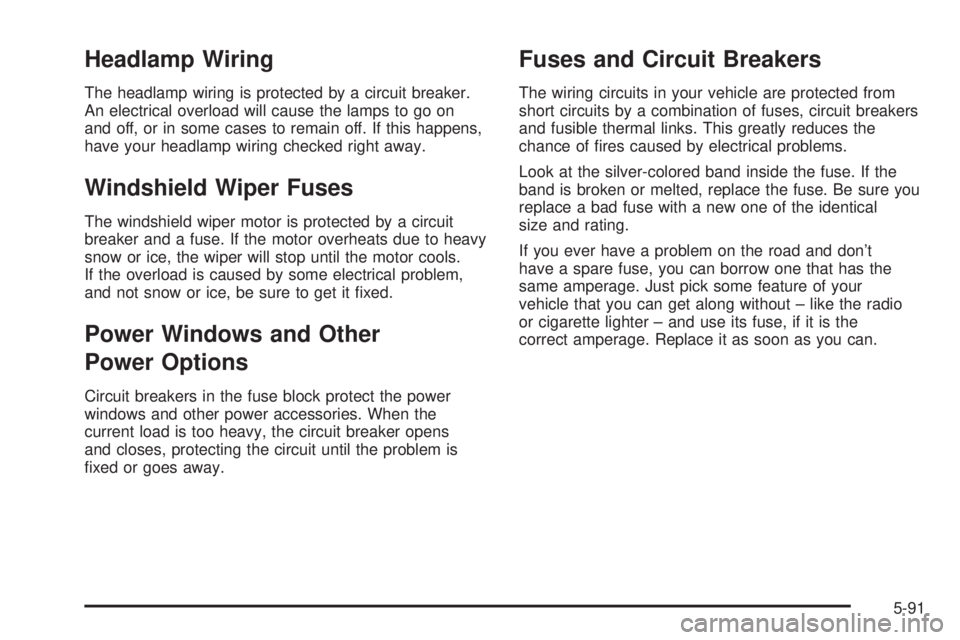
Headlamp Wiring
The headlamp wiring is protected by a circuit breaker.
An electrical overload will cause the lamps to go on
and off, or in some cases to remain off. If this happens,
have your headlamp wiring checked right away.
Windshield Wiper Fuses
The windshield wiper motor is protected by a circuit
breaker and a fuse. If the motor overheats due to heavy
snow or ice, the wiper will stop until the motor cools.
If the overload is caused by some electrical problem,
and not snow or ice, be sure to get it �xed.
Power Windows and Other
Power Options
Circuit breakers in the fuse block protect the power
windows and other power accessories. When the
current load is too heavy, the circuit breaker opens
and closes, protecting the circuit until the problem is
�xed or goes away.
Fuses and Circuit Breakers
The wiring circuits in your vehicle are protected from
short circuits by a combination of fuses, circuit breakers
and fusible thermal links. This greatly reduces the
chance of �res caused by electrical problems.
Look at the silver-colored band inside the fuse. If the
band is broken or melted, replace the fuse. Be sure you
replace a bad fuse with a new one of the identical
size and rating.
If you ever have a problem on the road and don’t
have a spare fuse, you can borrow one that has the
same amperage. Just pick some feature of your
vehicle that you can get along without – like the radio
or cigarette lighter – and use its fuse, if it is the
correct amperage. Replace it as soon as you can.
5-91
Page 337 of 368
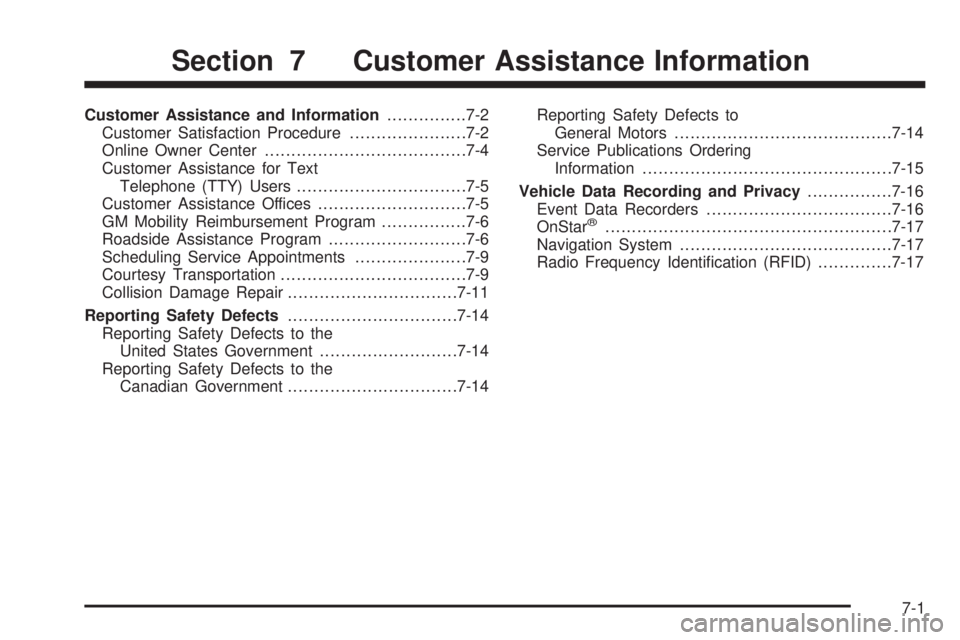
Customer Assistance and Information...............7-2
Customer Satisfaction Procedure......................7-2
Online Owner Center......................................7-4
Customer Assistance for Text
Telephone (TTY) Users................................7-5
Customer Assistance Offices............................7-5
GM Mobility Reimbursement Program................7-6
Roadside Assistance Program..........................7-6
Scheduling Service Appointments.....................7-9
Courtesy Transportation...................................7-9
Collision Damage Repair................................7-11
Reporting Safety Defects................................7-14
Reporting Safety Defects to the
United States Government..........................7-14
Reporting Safety Defects to the
Canadian Government................................7-14Reporting Safety Defects to
General Motors.........................................7-14
Service Publications Ordering
Information...............................................7-15
Vehicle Data Recording and Privacy................7-16
Event Data Recorders...................................7-16
OnStar
®......................................................7-17
Navigation System........................................7-17
Radio Frequency Identi�cation (RFID)..............7-17
Section 7 Customer Assistance Information
7-1
Page 352 of 368
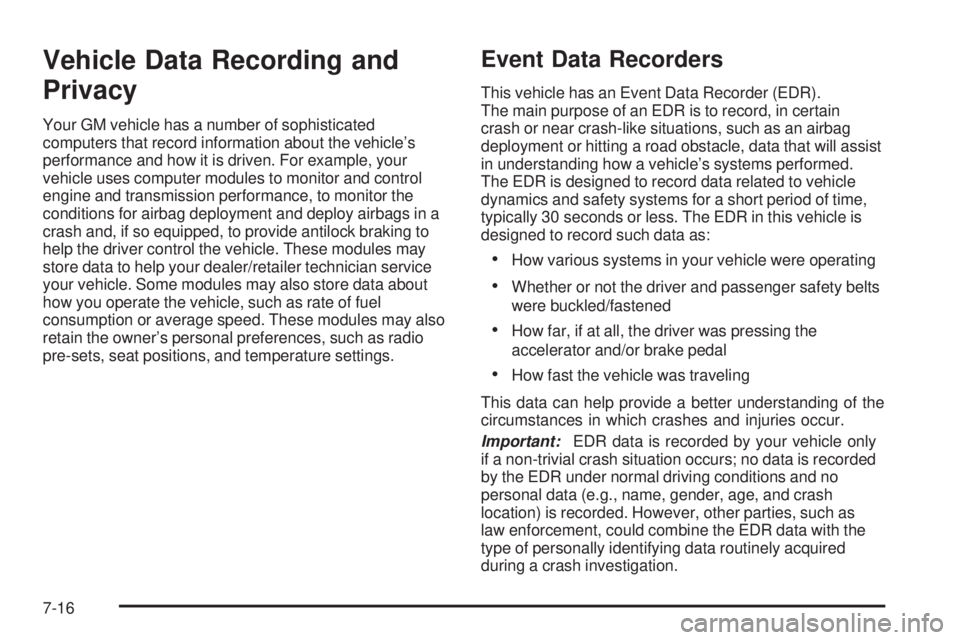
Vehicle Data Recording and
Privacy
Your GM vehicle has a number of sophisticated
computers that record information about the vehicle’s
performance and how it is driven. For example, your
vehicle uses computer modules to monitor and control
engine and transmission performance, to monitor the
conditions for airbag deployment and deploy airbags in a
crash and, if so equipped, to provide antilock braking to
help the driver control the vehicle. These modules may
store data to help your dealer/retailer technician service
your vehicle. Some modules may also store data about
how you operate the vehicle, such as rate of fuel
consumption or average speed. These modules may also
retain the owner’s personal preferences, such as radio
pre-sets, seat positions, and temperature settings.
Event Data Recorders
This vehicle has an Event Data Recorder (EDR).
The main purpose of an EDR is to record, in certain
crash or near crash-like situations, such as an airbag
deployment or hitting a road obstacle, data that will assist
in understanding how a vehicle’s systems performed.
The EDR is designed to record data related to vehicle
dynamics and safety systems for a short period of time,
typically 30 seconds or less. The EDR in this vehicle is
designed to record such data as:
How various systems in your vehicle were operating
Whether or not the driver and passenger safety belts
were buckled/fastened
How far, if at all, the driver was pressing the
accelerator and/or brake pedal
How fast the vehicle was traveling
This data can help provide a better understanding of the
circumstances in which crashes and injuries occur.
Important:EDR data is recorded by your vehicle only
if a non-trivial crash situation occurs; no data is recorded
by the EDR under normal driving conditions and no
personal data (e.g., name, gender, age, and crash
location) is recorded. However, other parties, such as
law enforcement, could combine the EDR data with the
type of personally identifying data routinely acquired
during a crash investigation.
7-16
Page 353 of 368
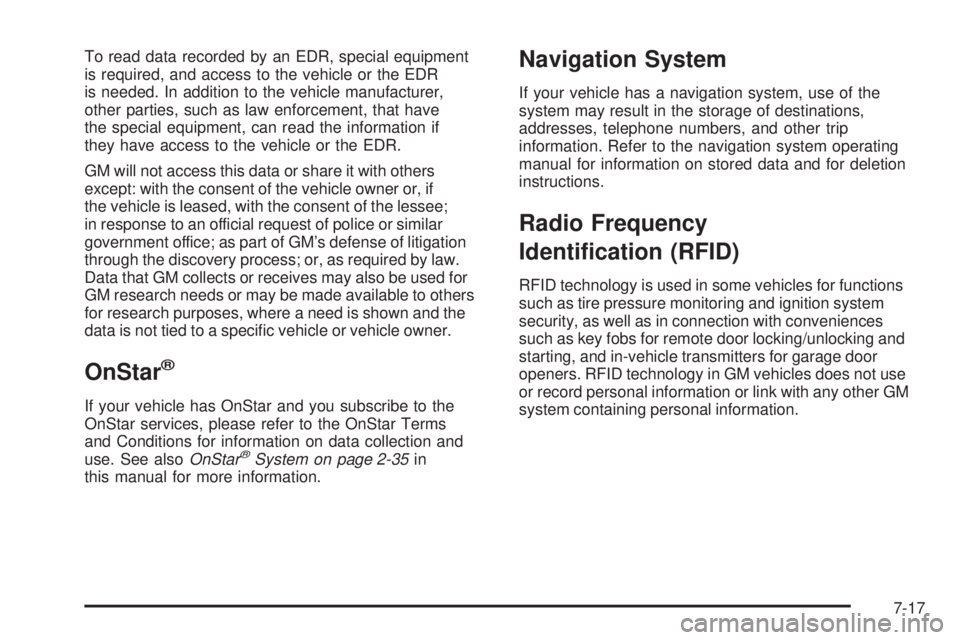
To read data recorded by an EDR, special equipment
is required, and access to the vehicle or the EDR
is needed. In addition to the vehicle manufacturer,
other parties, such as law enforcement, that have
the special equipment, can read the information if
they have access to the vehicle or the EDR.
GM will not access this data or share it with others
except: with the consent of the vehicle owner or, if
the vehicle is leased, with the consent of the lessee;
in response to an official request of police or similar
government office; as part of GM’s defense of litigation
through the discovery process; or, as required by law.
Data that GM collects or receives may also be used for
GM research needs or may be made available to others
for research purposes, where a need is shown and the
data is not tied to a speci�c vehicle or vehicle owner.
OnStar®
If your vehicle has OnStar and you subscribe to the
OnStar services, please refer to the OnStar Terms
and Conditions for information on data collection and
use. See alsoOnStar
®System on page 2-35in
this manual for more information.
Navigation System
If your vehicle has a navigation system, use of the
system may result in the storage of destinations,
addresses, telephone numbers, and other trip
information. Refer to the navigation system operating
manual for information on stored data and for deletion
instructions.
Radio Frequency
Identi�cation (RFID)
RFID technology is used in some vehicles for functions
such as tire pressure monitoring and ignition system
security, as well as in connection with conveniences
such as key fobs for remote door locking/unlocking and
starting, and in-vehicle transmitters for garage door
openers. RFID technology in GM vehicles does not use
or record personal information or link with any other GM
system containing personal information.
7-17
Page 355 of 368
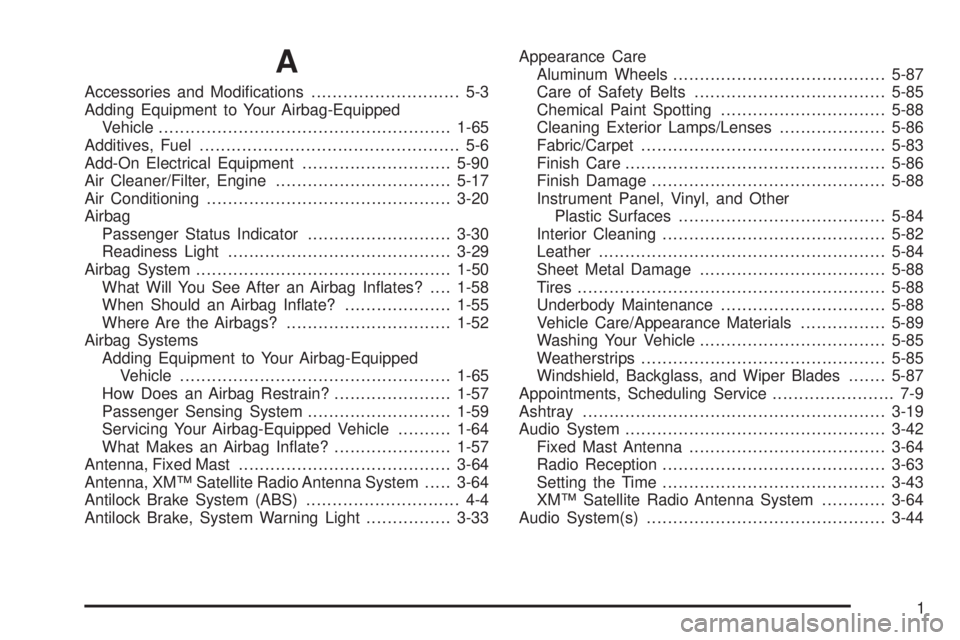
A
Accessories and Modi�cations............................ 5-3
Adding Equipment to Your Airbag-Equipped
Vehicle.......................................................1-65
Additives, Fuel................................................. 5-6
Add-On Electrical Equipment............................5-90
Air Cleaner/Filter, Engine.................................5-17
Air Conditioning..............................................3-20
Airbag
Passenger Status Indicator...........................3-30
Readiness Light..........................................3-29
Airbag System................................................1-50
What Will You See After an Airbag In�ates?....1-58
When Should an Airbag In�ate?....................1-55
Where Are the Airbags?...............................1-52
Airbag Systems
Adding Equipment to Your Airbag-Equipped
Vehicle...................................................1-65
How Does an Airbag Restrain?......................1-57
Passenger Sensing System...........................1-59
Servicing Your Airbag-Equipped Vehicle..........1-64
What Makes an Airbag In�ate?......................1-57
Antenna, Fixed Mast........................................3-64
Antenna, XM™ Satellite Radio Antenna System.....3-64
Antilock Brake System (ABS)............................. 4-4
Antilock Brake, System Warning Light................3-33Appearance Care
Aluminum Wheels........................................5-87
Care of Safety Belts....................................5-85
Chemical Paint Spotting...............................5-88
Cleaning Exterior Lamps/Lenses....................5-86
Fabric/Carpet..............................................5-83
Finish Care.................................................5-86
Finish Damage............................................5-88
Instrument Panel, Vinyl, and Other
Plastic Surfaces.......................................5-84
Interior Cleaning..........................................5-82
Leather......................................................5-84
Sheet Metal Damage...................................5-88
Tires..........................................................
5-88
Underbody Maintenance...............................5-88
Vehicle Care/Appearance Materials................5-89
Washing Your Vehicle...................................5-85
Weatherstrips..............................................5-85
Windshield, Backglass, and Wiper Blades.......5-87
Appointments, Scheduling Service....................... 7-9
Ashtray.........................................................3-19
Audio System.................................................3-42
Fixed Mast Antenna.....................................3-64
Radio Reception..........................................3-63
Setting the Time..........................................3-43
XM™ Satellite Radio Antenna System............3-64
Audio System(s).............................................3-44
1
Page 364 of 368

Power
Door Locks.................................................. 2-8
Electrical System.........................................5-91
Outlet 115 Volt Alternating Current.................3-18
Steering Fluid.............................................5-33
Windows....................................................2-13
Privacy..........................................................7-16
Event Data Recorders..................................7-16
Navigation System.......................................7-17
OnStar.......................................................7-17
Radio Frequency Identi�cation.......................7-17
R
Radiator Pressure Cap....................................5-26
Radio Frequency Identi�cation (RFID), Privacy......7-17
Radios..........................................................3-42
Radio(s)........................................................3-44
Radios
Reception...................................................3-63
Setting the Time..........................................3-43
Reading Lamps..............................................3-17
Rear Cargo Accessory Track System.................2-42
Rear Door Security Locks.................................. 2-9
Rear Seat Operation......................................... 1-8
Rear Storage Area..........................................2-41Rear Windshield Washer/Wiper.........................3-10
Rearview Mirror, Automatic Dimming..................2-34
Rearview Mirror with OnStar
®...........................2-33
Rearview Mirrors.............................................2-33
Reclining Seatbacks.......................................... 1-3
Recreational Vehicle Towing.............................4-25
Remote Keyless Entry (RKE) System.................. 2-3
Remote Keyless Entry (RKE) System,
Operation..................................................... 2-4
Removing the Flat Tire and Installing
the Spare Tire.............................................5-73
Removing the Spare Tire and Tools...................5-71
Replacement Bulbs.........................................5-48
Replacement Parts, Maintenance......................5-96
Reporting Safety Defects
Canadian Government..................................7-14
General Motors...........................................7-14
United States Government............................7-14
Restraint System Check
Checking the Restraint Systems....................1-66
Replacing Restraint System Parts
After a Crash..........................................1-67
Roadside
Assistance Program....................................... 7-6
Rocking Your Vehicle to Get it Out....................4-19
Routing, Engine Drive Belt...............................5-97
Running the Engine While Parked.....................2-32
10
Page 368 of 368
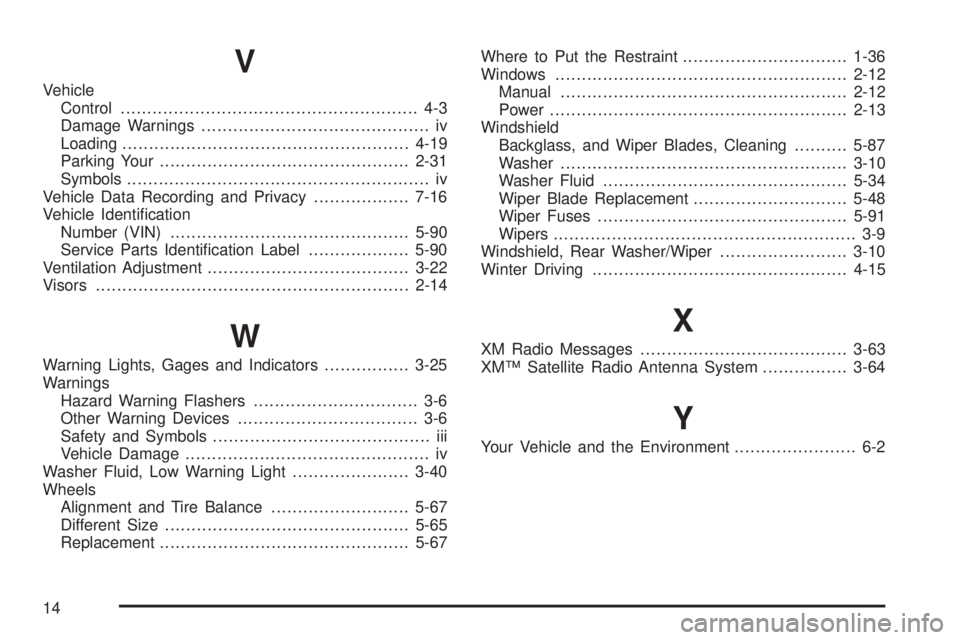
V
Vehicle
Control........................................................ 4-3
Damage Warnings........................................... iv
Loading......................................................4-19
Parking Your...............................................2-31
Symbols......................................................... iv
Vehicle Data Recording and Privacy..................7-16
Vehicle Identi�cation
Number (VIN).............................................5-90
Service Parts Identi�cation Label...................5-90
Ventilation Adjustment......................................3-22
Visors...........................................................2-14
W
Warning Lights, Gages and Indicators................3-25
Warnings
Hazard Warning Flashers............................... 3-6
Other Warning Devices.................................. 3-6
Safety and Symbols......................................... iii
Vehicle Damage.............................................. iv
Washer Fluid, Low Warning Light......................3-40
Wheels
Alignment and Tire Balance..........................5-67
Different Size..............................................5-65
Replacement...............................................5-67Where to Put the Restraint...............................1-36
Windows.......................................................2-12
Manual......................................................2-12
Power........................................................2-13
Windshield
Backglass, and Wiper Blades, Cleaning..........5-87
Washer......................................................3-10
Washer Fluid..............................................5-34
Wiper Blade Replacement.............................5-48
Wiper Fuses...............................................5-91
Wipers......................................................... 3-9
Windshield, Rear Washer/Wiper........................3-10
Winter Driving................................................4-15
X
XM Radio Messages.......................................3-63
XM™ Satellite Radio Antenna System................3-64
Y
Your Vehicle and the Environment....................... 6-2
14